Flag of the Second Spanish Republic
The flag of the Second Spanish Republic, known in Spanish as la tricolor,[1] was the official flag of Spain between 1931 and 1939 and the flag of the Spanish Republican government in exile until 1977.
.svg.png) | |
| Name | Tricolor |
|---|---|
| Use | |
| Proportion | 3:5 |
| Adopted | 27 April 1931 |
.svg.png) Variant flag of Second Spanish Republic | |
| Name | Bandera de la marina mercante (Civil Ensign) |
| Use | |
| Proportion | 3:5 |
.svg.png) Variant flag of Second Spanish Republic | |
| Name | Bandera militar (Military Flag) |
| Use | |
| Proportion | 2:3 |
History
The Spanish republican flag began to be used on April 27, 1931, thirteen days after municipal elections results led to the abolition of the monarchy and the proclamation of the Second Spanish Republic.
This same flag had been previously displayed by certain Republican groups as an alternative to the red-and-yellow flag that was identified with the Bourbon monarchy in Spain. As a result of this previous use, the young republic proclaimed in 1931 eagerly adopted this symbol.[2]
The Republican flag was adopted on April 27 and presented to the army of the nation on May 6 with the following words:[3] "The national uprising against tyranny, victorious since April 14, has hoisted a flag that is invested by means of the feelings of the people with the double representation of the hope of freedom and of its irreversible triumph."
El alzamiento nacional contra la tiranía, victorioso desde el 14 de abril, ha enarbolado una enseña investida por el sentir del pueblo con la doble representación de una esperanza de libertad y de su triunfo irrevocable.
The Republican flag was formed by three horizontal bands of the same width, red, yellow, and murrey (mulberry-coloured). The National Flag would have the Spanish Republican coat of arms at the centre (quarterly of Castile, Leon, Aragon and Navarre, enté en point for Granada, ensigned by a mural crown, between the two Pillars of Hercules). This coat of arms originated in 1868 and had been used then by the Provisional Government and later by the First Spanish Republic. The civil ensign or merchant flag would be a simple tricolour without the coat of arms.
The term "la tricolor" to refer to the flag is reminiscent of the French tricolor which, since the French Revolution of the late 18th Century, has made a flag composed of three equal strips into the symbol of a Republic. However, having horizontal strips rather than vertical ones, as in the French flag, made it possible to preserve many elements of the previous Spanish flag, used during centuries of Monarchial rule.
During the Civil War there was also a military version of the flag with proportion 2:3 and without the coat of arms used by Republican Army units in different locations. Despite not displaying the arms, this plain flag did not correspond to the civil ensign approved in 1931 for the use of merchant ships.[4] The International Brigades added a three-pointed red star to the yellow band of the military Republican flag.[5]
The simplified military flag of the Second Spanish Republic was also used by the Spanish Maquis between the end of the Spanish Civil War and the early 1960s, and later by the Spanish National Liberation Front (FELN). Versions of this flag were used in the 1970s by the radical anti-Francoist groups Revolutionary Antifascist Patriotic Front (FRAP) and First of October Anti-Fascist Resistance Groups (GRAPO).
The Republican flag is now widely used by trade unions[6] and left-wing political organizations, such as United Left,[7] the Marxist-Leninist Party (RC) and some factions of the Spanish Socialist Workers' Party. It is also used by republican platforms.[8][9]
Colours

.svg.png)
The Spanish Republican Flag has three colours: red, yellow, and dark purple.[10]
The third colour, dark purple (Spanish: morado oscuro), represents Castile and León by recalling the Pendón Morado, the ancient armorial banner of Castile. The colours of red and yellow symbolise the territories of the former Crown of Aragon.[11] These three colours symbolised a new era for Spain in which no part thereof was excluded and all Spaniards were represented.[2]
Morado
Morado, which is a generic word denoting the colour purple or violet, was previously a familiar colour in Spain because it is one of the Catholic liturgical colours that is displayed on vestments, altar cloths, and other ecclesiastical textile furnishings to signify certain seasons of the Catholic liturgical year, and, being a historically Catholic nation, this colour had annual and public use throughout Spain. Also, it was used in antiquity as the heraldic colour of the Kingdom of Castile. The coat of arms of the Kingdom of León bore a purple lion rampant and the flag reputed to have been used in the Revolt of the Comuneros displayed a yellow castle on a purple background. Morado, however, was and is prone to variations in hue and fading from time and use, which often resulted in "morado" denoting a range of hues of purple, which presently are considered distinct colours/hues, e. g. crimson or maroon. Because it is rarely present on flags, in practice the morado of the lowest band of the Flag was coloured violet, purple (purpure), or even lilac, contingent on available materials and dyes.[12]
Controversies
Spanish monarchists resented the morado of the new tricolored flag and a famous soleá was composed when the Flag began to be used. These verses also indirectly expressed dissatisfaction for the reforms of the new republican government:[13]
Me está jodiendo el morao, |
I am bothered by the morado, |
Since the restoration of the monarchy in the last quarter of the 20th century, some authors contradict previous Spanish historians by arguing that the Castilian Pendón Morado never existed or that it was actually coloured red.
Until recently the official badge of the Real Madrid C.F. had a purple band based either on the Castilian or Spanish republican colours which was added after the proclamation of the Second Spanish Republic in 1931.[14][15] The colour of the band was changed from morado to navy blue in 2001.
Depictions, derivatives and variants
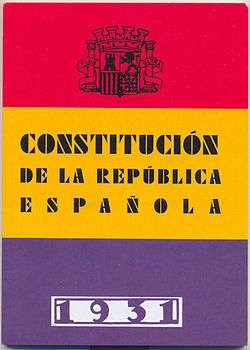 Cover of the Constitution of the Second Spanish Republic
Cover of the Constitution of the Second Spanish Republic Allegory of the Spanish Republic
Allegory of the Spanish Republic Statue of Liberty Spanish stamp honoring the 150th anniversary of the U.S. Constitution
Statue of Liberty Spanish stamp honoring the 150th anniversary of the U.S. Constitution Allegory of the Spanish Republic embracing Marianne, symbolizing the French Republic. 1931
Allegory of the Spanish Republic embracing Marianne, symbolizing the French Republic. 1931 Spanish Medical Aid Committee armband[16]
Spanish Medical Aid Committee armband[16]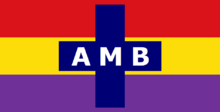 American Medical Bureau (AMB) armband
American Medical Bureau (AMB) armband Grave of President Manuel Azaña (1880-1940) in Montauban, France
Grave of President Manuel Azaña (1880-1940) in Montauban, France German Democratic Republic medal of Hans Beimler
German Democratic Republic medal of Hans Beimler Order of the Spanish Republic in Exile
Order of the Spanish Republic in Exile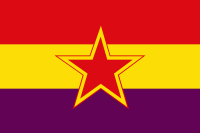
 PML (RC) flag
PML (RC) flag_alternative.svg.png) PML (RC) alternative flag
PML (RC) alternative flag
Civil use
 Presidential Standard of Niceto Alcalá-Zamora (1931-1936)
Presidential Standard of Niceto Alcalá-Zamora (1931-1936) Presidential Standard of Manuel Azaña (1936-1939)
Presidential Standard of Manuel Azaña (1936-1939) Ministerial Standard
Ministerial Standard Yacht ensign used on recreational boats or ships (1931-1939)
Yacht ensign used on recreational boats or ships (1931-1939)
Military use
 Spanish Republican Army flag used in the Battle of the Ebro
Spanish Republican Army flag used in the Battle of the Ebro Flag of the 44th Division of the Spanish Popular Army
Flag of the 44th Division of the Spanish Popular Army The flag of the International Brigades
The flag of the International Brigades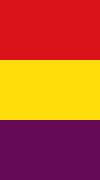
 Polikarpov I-15 of the Spanish Republican Air Force
Polikarpov I-15 of the Spanish Republican Air Force Roundel of the Spanish Republican Air Force
Roundel of the Spanish Republican Air Force Fin flash of the Aeronáutica Naval, the naval aviation of the Spanish Republican Navy (1931-1936)
Fin flash of the Aeronáutica Naval, the naval aviation of the Spanish Republican Navy (1931-1936) Spanish Republican Navy. Ensign of the Viceadmiral of the Fleet
Spanish Republican Navy. Ensign of the Viceadmiral of the Fleet Spanish Republican Navy. Captain at Sea Pennant
Spanish Republican Navy. Captain at Sea Pennant- Spanish Republican Navy. Senior Officer Pennant
Present-day use
- Flag of the Second Spanish Republic in Eibar
 Office of the Izquierda Republicana party in León
Office of the Izquierda Republicana party in León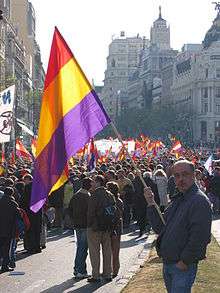 Pro-Republican demonstration; Madrid 2006
Pro-Republican demonstration; Madrid 2006 Spanish Republican flags in a demonstration in Oviedo, April 2009
Spanish Republican flags in a demonstration in Oviedo, April 2009 Pro-Republican demonstration in Tenerife, Canary Islands, April 2007
Pro-Republican demonstration in Tenerife, Canary Islands, April 2007 Pro-Republican demonstration in Seville, April 2006
Pro-Republican demonstration in Seville, April 2006- Monument to former Los Llanos de Aridane Republican major Francisco Rodríguez Betancourt. The flag on the left with its oversized coat of arms is a recent commercial version.
 Madrid 19 June 2011 demonstration
Madrid 19 June 2011 demonstration 2012 demonstration in Las Palmas
2012 demonstration in Las Palmas- Republican demonstration in the Puerta del Sol on the day that Juan Carlos I announced his decision to abdicate
 Use as a symbol in Barcelona during the campaign for the 2017 Catalan independence referendum
Use as a symbol in Barcelona during the campaign for the 2017 Catalan independence referendum
See also
References
- La Tricolor. Breve historia de la Bandera Republicana
- La Tricolor. Breve historia de la Bandera Republicana
- Decreto de 27 de abril de 1931 de Presidencia del Gobierno Provisional de la República.
- Gaceta de Madrid, Decreto del 27 de abril de 1931 del gobierno provisional de la República, 28 April 1931
- FOTW - Spanish Civil War 1936-1939
- Workers' Commissions demonstration
- "United Left logo". Archived from the original on 2012-12-19. Retrieved 2012-01-28.
- Republican demonstration
- demonstration
- Decreto del 27 de abril de 1931 de la Presidencia del Gobierno Provisional de la República. La bandera de la República española es "roja..., amarilla... y morada oscura..."
- Poster - Allegory of the Spanish Republic.
- Versions of the colours of the Flag of the Second Spanish Republic.
- ABC - La república.
- Los coloures «republicanos» del Real Madrid - ABC.es.
- La Franja Morada.
- Spanish Medical Aid Committee
External links
| Wikimedia Commons has media related to Flags of the Spanish Second Republic. |
- Armada Española - Segunda República (1931 - 1939)
- The Flags of Spain. Flags of the World
- Asturias Republicana
- Ministerio de Defensa - Insignias Jefes de Estado; Presidente de la II República
- Second Spanish Republic National Anthem
- Images
- La bandera de la República Española ondea por primera vez en París
- La Bandera Republicana ondea en París